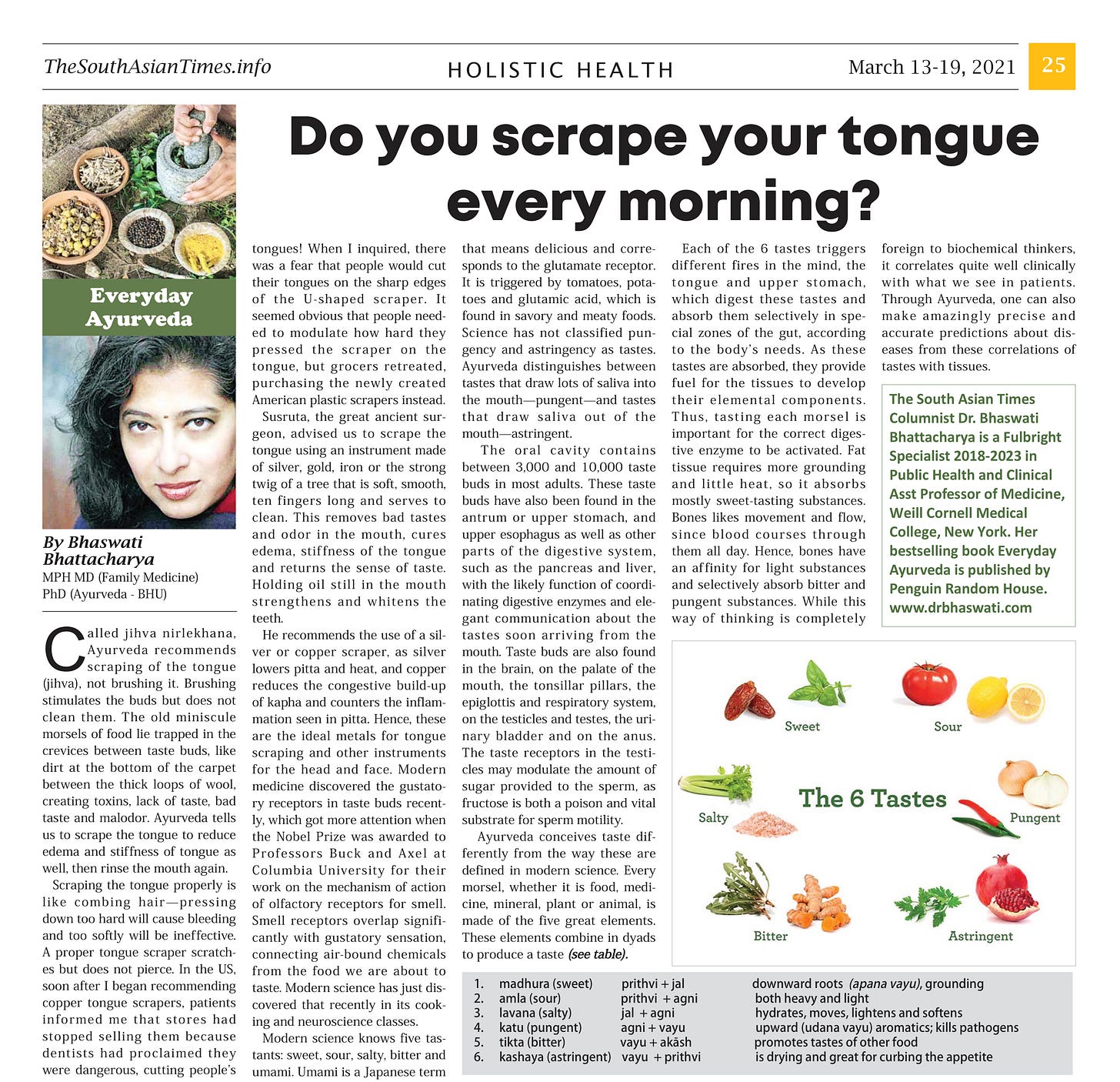Do you Scrape your Tongue Every Morning?
Through Ayurveda, one can also make amazingly precise and accurate predictions about diseases from these correlations of tastes with tissues.
Do you Scrape your Tongue Every Morning?
Called jihva nirlekhana, Āyurveda recommends scraping of the tongue (jihva), not brushing it. Brushing stimulates the buds but does not clean them. The old miniscule morsels of food lie trapped in the crevices between taste buds, like dirt at the bottom of the carpet between the thick loops of wool, creating toxins, lack of taste, bad taste and malodour. Āyurveda tells us to scrape the tongue to reduce edema and stiffness of tongue as well, then rinse the mouth again.
Scraping the tongue properly is like combing hair—pressing down too hard will cause bleeding and too softly will be ineffective. A proper tongue scraper scratches but does not pierce. In the US, soon after I began recommending copper tongue scrapers, patients informed me that stores had stopped selling them because dentists had proclaimed they were dangerous, cutting people’s tongues! When I inquired, there was a fear that people would cut their tongues on the sharp edges of the U-shaped scraper. It seemed obvious that people needed to modulate how hard they pressed the scraper on the tongue, but grocers retreated, purchasing the newly created American plastic scrapers instead.
Susruta, the great ancient surgeon, advised us to scrape the tongue using an instrument made of silver, gold, iron or the strong twig of a tree that is soft, smooth, ten fingers long and serves to clean. This removes bad tastes and odour in the mouth, cures edema, stiffness of the tongue and returns the sense of taste. Holding oil still in the mouth strengthens and whitens the teeth.
He recommends the use of a silver or copper scraper, as silver lowers pitta and heat, and copper reduces the congestive build-up of kapha and counters the inflammation seen in pitta. Hence, these are the ideal metals for tongue scraping and other instruments for the head and face.
Modern medicine discovered the gustatory receptors in taste buds recently, which got more attention when the Nobel Prize was awarded to Professors Buck and Axel at Columbia University for their work on the mechanism of action of olfactory receptors for smell. Smell receptors overlap significantly with gustatory sensation, connecting air-bound chemicals from the food we are about to taste. Modern science has just discovered that recently in its cooking and neuroscience classes.
Modern science knows five tastants: sweet, sour, salty, bitter and umami. Umami is a Japanese term that means delicious and corresponds to the glutamate receptor. It is triggered by tomatoes, potatoes and glutamic acid, which is found in savoury and meaty foods. Science has not classified pungency and astringency as tastes. Āyurveda distinguishes between tastes that draw lots of saliva into the mouth—pungent—and tastes that draw saliva out of the mouth—astringent.
The oral cavity contains between 3,000 and 10,000 taste buds in most adults. These taste buds have also been found in the antrum or upper stomach, and upper esophagus as well as other parts of the digestive system, such as the pancreas and liver, with the likely function of coordinating digestive enzymes and elegant communication about the tastes soon arriving from the mouth. Taste buds are also found in the brain, on the palate of the mouth, the tonsillar pillars, the epiglottis and respiratory system, on the testicles and testes, the urinary bladder and on the anus. The taste receptors in the testicles may modulate the amount of sugar provided to the sperm, as fructose is both a poison and vital substrate for sperm motility.
Āyurveda conceives taste differently from the way these are defined in modern science. Every morsel, whether it is food, medicine, mineral, plant or animal, is made of the five great elements. These elements combine in dyads to produce a taste.
madhura (sweet) prithvi + jal downward roots (apana vayu), grounding
amla (sour) prithvi + agni both heavy and light
lavana (salty) jal + agni hydrates, moves, lightens and softens
katu (pungent) agni + vayu upward (udana vayu) aromatics; kills pathogens
tikta (bitter) vayu + akāsh promotes tastes of other food
kashaya (astringent) vayu + prithvi is drying, great for curbing the appetite
Each of these tastes triggers different fires in the mind, the tongue and upper stomach, which digest these tastes and absorb them selectively in special zones of the gut, according to the body’s needs. As these tastes are absorbed, they provide fuel for the tissues to develop their elemental components. Thus, tasting each morsel is important for the correct digestive enzyme to be activated. Fat tissue requires more grounding and little heat, so it absorbs mostly sweet-tasting substances. Bones likes movement and flow, since blood courses through them all day. Hence, bones have an affinity for light substances and selectively absorb bitter and pungent substances. While this way of thinking is completely foreign to biochemical thinkers, it correlates quite well clinically with what we see in patients. Through Āyurveda, one can also make amazingly precise and accurate predictions about diseases from these correlations of tastes with tissues.
week50. TheSouthAsianTimes.
Download the .pdf version of this column by clicking on the image.
Dr. Bhaswati Bhattacharya is a Fulbright Specialist 2018‐2023 in Public Health. She serves as Clinical Asst Professor of Family Medicine in the Department of Medicine at Weill Cornell Medical College in New York, NY. Her bestselling book Everyday Ayurveda is published by Penguin Random House. To order an autographed copy, write to bhaswati@post.harvard.edu.





